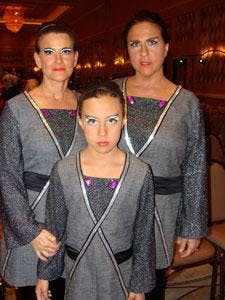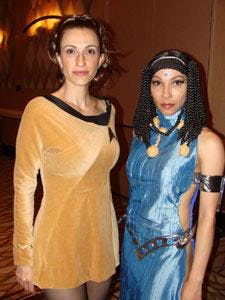Published Mar 27, 2014
A Study on Geek Girls, Part 2
A Study on Geek Girls, Part 2

While anthropologists are commonly thought of as the experts on exotic and so-called "Primitive" societies, this popular misconception does not reflect the contemporary field of anthropology. What you may have seen in Star Trek: The Next Generation episodes such as "Who Watches the Watchers?" does indeed represent what our profession used to be like, and still is for some of us. However, anthropologists work in a variety of fields nowadays. They study online communities such as World of Warcraft guilds, the social importance of food, or, in my case, geek culture.

Since late 2012, I have been analyzing this debate and following the changes it brought forth in geek culture.
I was curious to know why the debate had gained such intensity and visibility at the moment when it did. But, as I expressed in part one of this series, I was also puzzled by several of the arguments put forth in ''rants,'' for lack of a better word, against alleged fake geek girls: that women were rare in geek culture, that female participation in geek culture was recent or had recently increased, that girls focused on their own appearance were not true geeks, etc.
In this series, I will provide:
- A description and analysis of a few major events in the Fake Geek Girl debate and analyze the ''rants.'' for lack of a better word, against alleged fake geek girls as well as the responses they elicited.
- A brief discussion of the two main theories proposed by participants in the debate regarding the context which led to its intensification in 2012.
- An exploration of avenues of investigation to further our understanding of the current gender dynamics within geek culture.
- Concluding remarks presenting the Geek Girl Survey, the second step of the research process I have initiated, and some consequences of the Fake Geek Girl Debate.
Methodology
For this project, I adopted a Grounded Theory (GT) approach,

Adopting a GT also demands, at least in a constructivist paradigm, that the results be clearly presented in relation to the research process and the data itself, as the emergent theory is seen as a process which is not final. In other words, this approach favors transparency, and cautions against preconceived ideas, biases and generalisations. To learn more consult the reference section of this Wikipedia page and the Grounded Theory Institute’s official website.
The fake geek girl debate takes place in news reports, blogs, social networks, images, videos, their respective comment thread as well as between individuals offline. Because the preparation of this paper was the first step in my research process on geek girls, I selected exclusively digital contents, such as articles, blog posts, news reports, videos, memes and other images.
At first, I selected rants and responses according to the intensity of the debates they caused. I looked at the number of comments, ''shares'' and ''likes'' on social networks, the number of views and the rebuttals or approvals expressed in other online spaces. As my analysis progressed, I started looking more specifically for material which might provide additional insight and new perspectives. This is how I managed to limit the quantity of material listed in my analysis chart, although I had to review much more to proceed to selection.
In the end, I selected 6 rants and over 40 responses which I classified in a Mind42 chart. Whenever possible, I respected a chronological order and I linked rants and their responses in the same branch. However, note that despite my best efforts, this chart only provides a partial representation of the links between the selected sources. In reality, rants and responses are tightly connected in web of references to one another, comments, conversations on social networks, retweets and so on.
Additionally, I caution you not to jump to conclusions when looking at the chart. It represents my own path through the jungle of the Internet, not the statistical incidence of responses to each rant. For instance, it would also be naive to conclude that the chart proves that most people are opposed to the fake geek girl debate. I found fewer rants than responses, yes. But rants are not always highly publicized or written by celebrities: they can be shared in comment threads, between friends in private forums, and, more importantly, expressed through attitude rather than words.

The chart keeps growing, and although I did consult all sources listed in the chart, no new material has significantly altered my first conclusions. The sources which were analyzed in the first round phase of this project, and which are described in this series, are identified with ''check'' icons for clarity purposes.
Next week, I will introduce a summary of my analysis of the rants I selected for my project. Till then, feel free to recommend any source you think I might have overlooked and to engage in a respectful and constructive.
Click HERE to read the foreword to this series, A Study On Geek Girls, Part 1.
Marie-Pierre Renaud is graduate student of sociocultural anthropology in Laval University, Quebec, Canada. She specializes in native studies and her work focuses on healing and reconciliation processes. As the founder and a co-editor of The Geek Anthropologist blog, which is dedicated to the anthropological study of geek culture and all things geek, she writes about women in geek culture, the representations of indigenous peoples in science-fiction, and the changing definitions of geekiness. She can be reached at thegeekanthropologist[at]gmail.com

